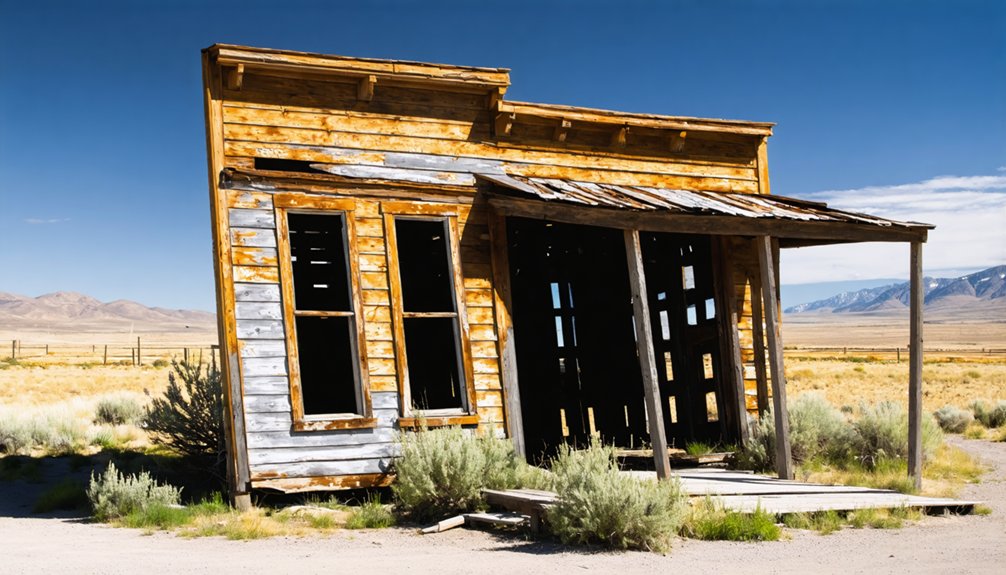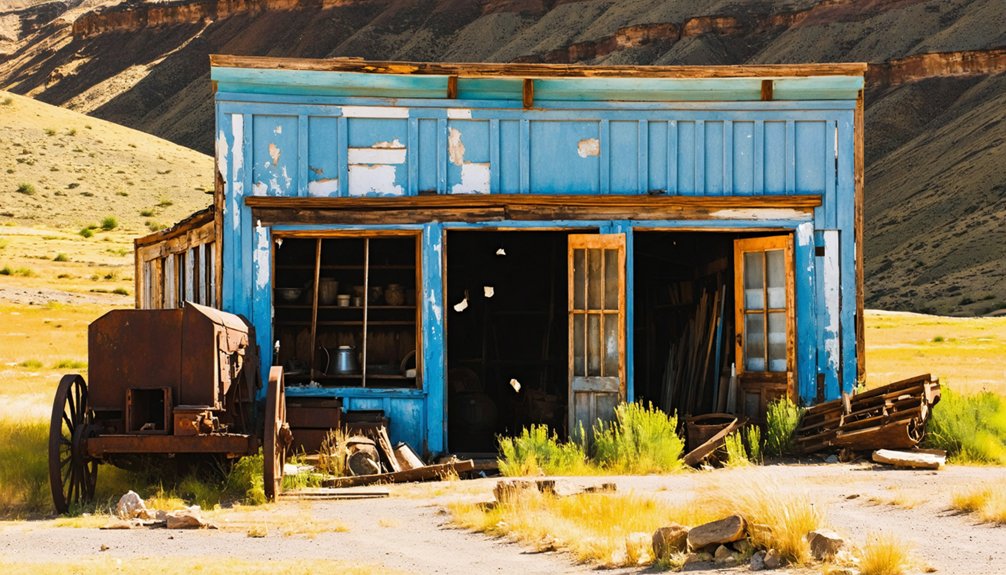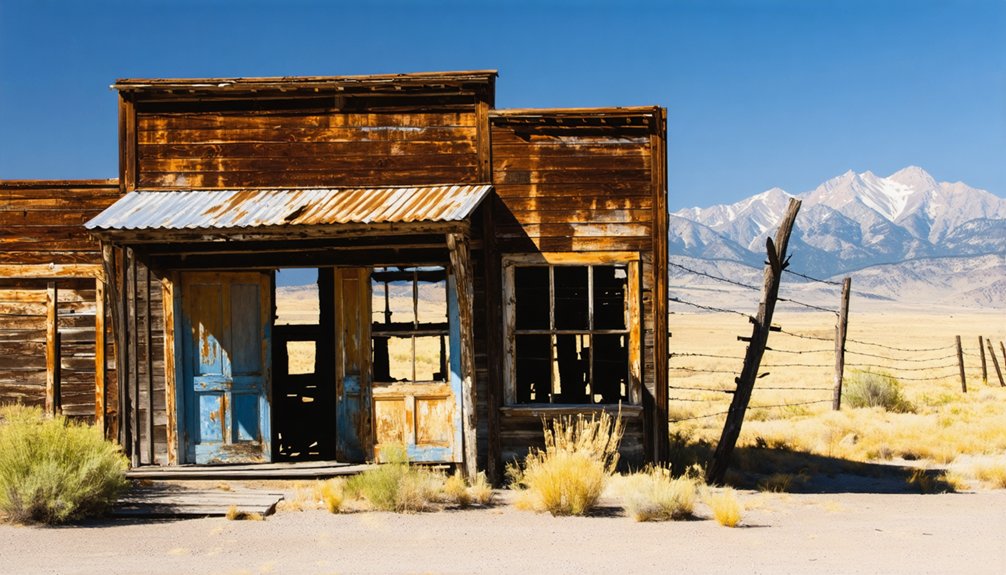You’ll find Broadford’s story beginning in 1879 as Jacobs City, before transforming into a thriving silver mining hub along Idaho’s Wood River Valley. The town reached its peak in 1884 with 600 residents, powered by rich silver-lead deposits that produced over $2 million annually. Major operations like the Bullion Mine, which sold for $1,050,000, attracted British investors. While mining challenges and economic fluctuations eventually led to abandonment, Broadford’s preserved structures still tell tales of its prosperous past.
Key Takeaways
- Broadford was established in 1879 as a mining boomtown in Idaho’s Wood River Valley, thriving on rich silver-lead deposits.
- The town reached its peak population of 600 residents in 1884 during the height of mining operations.
- Economic decline began when mines became less productive, leading to the gradual exodus of miners and their families.
- The Great Fire of 1910 significantly damaged the town’s structures, contributing to its eventual abandonment.
- Surviving structures showcase late 19th-century architectural styles, including Italianate and Victorian influences with ornate detailing.
The Rise of a Mining Frontier Town
When prospectors discovered rich mineral deposits in Idaho’s Wood River Valley, the settlement of Jacobs City emerged in 1879, quickly transforming into Broadford by 1880 during the region’s mining rush.
You’ll find that Broadford’s strategic location along the valley’s main transportation corridor made it an essential hub for miners, merchants, and stagecoaches seeking their fortunes.
The rapid growth of mining settlements in the Wood River Valley area led to an impressive population boom, with nearby towns like Hailey and Bellevue reaching 10,000 residents during the 1880s.
Silver and Lead: The Foundations of Wealth
The mineral wealth of Broadford’s mining district rested primarily on its rich silver-lead deposits, which yielded impressive concentrations of valuable ore.
You’ll find that silver mining and lead production quickly surpassed gold mining operations in the 1880s, transforming the region into an economic powerhouse. These operations reflected the broader trend of lead-silver recovery dominating Idaho’s mining industry during this period.
The Wood River mines reached a major milestone when over $2 million in annual production was achieved for three consecutive seasons after railroad completion.
The district’s major mines delivered remarkable results:
- Independence Mine extracted over 131,000 tons of ore by 1923, averaging 5.2% lead and 13.4 ounces of silver per ton.
- North Star Mine achieved $800,000 in production by 1915, boasting zinc-rich deposits.
- Triumph Mine emerged as the district’s largest base-metal producer, generating $28-29 million between 1936 and 1957.
British investors recognized this potential, as evidenced by the Bullion Mine‘s significant $1,050,000 sale price, which included $685,000 in cash with substantial ore reserves still intact.
Life in Broadford’s Heyday
Rich mineral deposits weren’t the only defining feature of Broadford during its peak years – vibrant community life pulsed through this mining settlement.
You’d find a diverse mix of miners, sheepherders, and merchants creating unique community dynamics as they navigated daily life in this rugged terrain. The town reached its zenith with around 600 residents in 1884, making it a significant hub for the region. Cultural influences from various backgrounds shaped the town’s character, evident in the bustling saloons and social gatherings that offered respite from hard labor.
While facing harsh winters and limited medical care, families forged strong bonds and relied on neighboring towns like Ketchum and Hailey for trade and support. Shoshone and Bannock tribes had inhabited these lands for generations before the mining boom began.
You’d travel these connections by horseback or wagon, braving rough dirt roads to maintain essential links with the region’s mining and agricultural networks.
Mining Challenges and Geological Hurdles
Despite promising surface deposits, Broadford’s miners faced formidable geological complexities that challenged their extraction efforts throughout the district’s history. The district’s notorious “pinch and swell” ore bodies would suddenly vanish against fault lines, leaving miners staring at barren rock walls where rich veins had once existed.
- You’d find miners conducting detailed geological surveys to track displaced veins, often requiring decades to rediscover lost ore bodies beyond major faults like Rockwell and Minnie.
- Mining technology struggled to keep pace with the area’s demands, as remote locations limited access to skilled technicians and essential machinery repairs.
- Even when ore was found, you’d face steep costs shipping it to distant smelters, with transport expenses exceeding $10 per ton compared to local smelting costs of $6.50-$7.50.
Community Infrastructure and Daily Living
As miners flocked to the area’s promising silver deposits, Broadford emerged as a practical support hub with essential amenities you’d expect in a frontier mining town.
You’d find a bustling general store, hotels, and saloons where miners gathered after long days underground. The town’s layout was compact, with closely spaced commercial buildings and simple dwellings built from local timber. Much like Silver City which had 75 businesses servicing its mining community, Broadford maintained a variety of shops and services. The arid climate helped preserve many of the original wooden structures.
Daily life revolved around basic transportation methods – horses, wagons, and foot travel along rugged trails. While formal community services were limited, with no documented school or church, social gatherings thrived in the saloons and during outdoor celebrations.
Life in Broadford meant rugged trails, horses and wagons, with community spirit found in saloons rather than churches.
You’d occasionally catch traveling shows or join Independence Day festivities outside town. Though lacking modern infrastructure like railways or telegraphs, Broadford maintained its frontier spirit until larger towns like Bellevue drew residents away.
The Great Fires That Changed Everything
During the catastrophic Great Fire of 1910 that swept through the Northern Rockies, you’d have witnessed Broadford’s buildings succumb to the massive firestorm that consumed 3 million acres across Idaho, Montana, and Washington.
You would’ve seen the town’s residents frantically trying to save what they could as hurricane-force winds turned the scattered fires into an unstoppable inferno on August 20-21.
Early snowpack melt and extreme drought conditions that year created the perfect environment for the devastating fires to spread rapidly.
The loss of Broadford’s structures marked a turning point that led to stronger fire prevention policies across the American West, though the ghost town’s burned remnants stand as a memorial to that devastating summer. Smoke from the destructive blaze was seen as far away as Watertown, New York, showing the fire’s incredible reach.
Devastating Flames Sweep Through
When lightning storms and severe drought conditions collided with human-caused ignitions in 1910, they triggered one of America’s most devastating wildfires across Northern Idaho.
You’d have witnessed nature’s raw power as hurricane-force winds whipped flames hundreds of feet high, turning the afternoon sky pitch black while whole mountainsides ignited instantly.
- The wildfire impact was catastrophic – you couldn’t escape the smoke that traveled as far as Boston, with soot reaching Greenland.
- Trees exploded like Roman candles, hurled through the air as burning projectiles while flames jumped massive canyons.
- Community resilience emerged through heroes like Edward Pulaski, who saved 34 firefighters by leading them into a mine adit for shelter. The three million acres burned devastated the region’s forests and claimed the lives of 78 firefighters.
Fire Prevention Back Then
The devastating 1910 fires revolutionized America’s approach to fire prevention. You’d have seen the U.S. Forest Service, established just five years earlier, leading a crusade against all wildfires. They didn’t yet understand fire’s ecological role, rejecting local practices like controlled burns in favor of total suppression.
If you’d visited Idaho’s forests in the 1930s, you’d have found a web of new fire safety infrastructure – lookout towers, ranger stations, and weather monitoring systems.
The Clearwater National Forest pioneered detailed mapping and planning in 1932, showing exactly how quickly firefighters could reach any location. By 1935, you couldn’t escape the strict “10 a.m. policy” – every fire had to be controlled by morning.
These historical measures shaped today’s approach, though we’ve learned that not all fire is the enemy.
Buildings Lost Forever
As hurricane-force winds swept through Idaho on August 20, 1910, they transformed scattered blazes into an unprecedented firestorm that would forever alter Broadford’s landscape.
You’d have watched in horror as flames shot hundreds of feet skyward, while embers traveled at 70 miles per hour, igniting everything in their path. Lost landmarks vanished in minutes as the inferno devoured the town’s wooden structures.
- Shellacked houses and cedar-shake churches collapsed under the intense heat, erasing precious community memories.
- Plank sidewalks and essential infrastructure burned away, leaving towns struggling to recover.
- Historic mines, sawmills, and water sources were destroyed, forcing residents to abandon their homes and businesses.
The fire’s legacy lives on in Broadford’s empty streets, where only memories remain of the buildings lost forever.
From Boom to Abandonment
During its peak in 1884, Broadford bustled with nearly six hundred residents who relied on the prosperous Minnie Moore and Queen of the Hills mines.
You’d find a thriving community that served the needs of these operations, which ranked among the territory’s richest mineral producers.
The population trends followed the typical boom-and-bust cycle of mining towns. As the mines began yielding less gold and silver, economic fluctuations hit the community hard.
You would’ve witnessed the gradual exodus of miners and their families as the ore deposits diminished. The harsh environment and challenging transportation conditions only accelerated the town’s decline.
Without its mining backbone, Broadford couldn’t sustain itself, and the once-vibrant community slowly faded into abandonment, ultimately leading to the complete leveling of the town site.
Architectural Legacy and Remaining Structures

While much of Broadford’s physical presence has vanished, its architectural legacy lives on through several surviving structures that showcase late 19th-century building styles. These buildings, constructed during the town’s mining boom, reflect the architectural styles common to Western boomtowns, including Italianate and Victorian influences.
- You’ll find two-story mercantile buildings along Main Street, including the I.O.O.F. Hall, which features distinctive galvanized iron facades and ornate bracketed entablatures.
- The remaining homes display intricate woodwork and gingerbread detailing on their porch brackets, telling stories of frontier craftsmanship.
- Agricultural structures, such as barns and stables, stand as evidence of the town’s diverse economy.
Today’s preservation challenges include securing funding and battling environmental deterioration, yet these structures remain essential links to Broadford’s vibrant past.
Tales From the Mining Era
Once fortune seekers discovered the Wood River area’s rich mineral deposits in 1862, Broadford’s mining saga began to unfold.
You’ll find mining legends centered around Frank Jacobs, who discovered the Queen of the Hills mine and gave the town its original name of Jacobs City.
The area’s ghost stories often revolve around the Minnie Moore Mine, discovered in 1880, where miners faced treacherous “pinch and swell” ore deposits.
As you explore the region’s history, you’ll learn how thousands of prospectors rushed to strike it rich, transforming tiny settlements into bustling towns.
The Minnie Moore and Queen of the Hills mines drew fortune hunters who braved harsh winters and challenging conditions.
They used mercury-coated copper plates and stamp mills, leaving behind tales of both triumph and tragedy in their quest for silver and gold.
Preserving Idaho’s Mining Heritage

Today’s efforts to protect Idaho’s mining legacy build upon those early tales of fortune seekers and prospectors. Through historical preservation and mine reclamation projects, you’ll find dedicated teams working to safeguard both the structures and stories that shaped the region.
- The White Knob Historical Preservation Committee has taken the lead in stabilizing historic mining structures near Mackay, including the iconic Shay railroad trestle and tramway towers.
- You can explore this rich heritage through guided tours and interpretive signage along the Mackay Mine Hill Tour.
- Federal and state funding, combined with public-private partnerships, make these preservation efforts possible, while modern reclamation techniques address environmental concerns at Idaho’s 8,800 abandoned mine sites.
These collaborative efforts guarantee that future generations can experience Idaho’s mining heritage while protecting the environment.
Frequently Asked Questions
Are There Any Paranormal Activities Reported in Broadford’s Abandoned Buildings?
Despite rumors whispering through dusty halls, you won’t find official ghost sightings or haunted locations in Broadford’s remains. Available records, paranormal databases, and local sources don’t support any supernatural claims there.
What Happened to the Mining Equipment After the Town Was Abandoned?
You’ll find most mining equipment was left behind due to high transport costs, with larger machinery abandoned on-site, while smaller tools were scavenged, leaving only historically significant remnants to rust away.
Can Visitors Legally Collect Artifacts From the Broadford Ghost Town Site?
No, you can’t collect artifacts from Broadford’s site. Removing historical items violates private property laws and artifact conservation regulations. You’ll face serious legal ramifications, including fines and potential criminal charges.
Which Months Offer the Best Weather Conditions for Exploring Broadford?
You’ll find the best months and weather conditions from July through September, with July being ideal – expect warm days around 70°F, cool nights, minimal precipitation, and long daylight hours for exploring.
Are There Any Descendants of Original Broadford Miners Still Living Nearby?
While descendant stories suggest some mining families settled in nearby Bellevue and Ketchum, you’ll find it’s hard to confirm specific family connections due to limited genealogical records from Broadford’s era.
References
- https://www.ghosttowns.com/states/id/bellevue.html
- https://valleychamber.org/idaho-mines/
- https://yellowpinetimes.wordpress.com/2019/09/08/idaho-history-sept-8-2019/
- https://npshistory.com/publications/blm/historic-mines-blaine-co.pdf
- https://en.wikipedia.org/wiki/List_of_ghost_towns_in_Idaho
- https://www.youtube.com/watch?v=1hF2mr–zTs
- https://idaho-forged.com/idahos-ghost-towns-eerie-yet-approachable/
- https://history.idaho.gov/wp-content/uploads/0206.pdf
- https://history.idaho.gov/wp-content/uploads/2018/08/0009.pdf
- https://www.co.blaine.id.us/328/History



